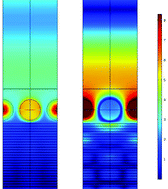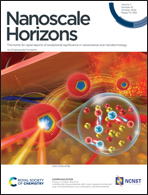Optical response of hyperbolic metamaterials with adsorbed nanoparticle arrays†
Abstract
Experimental studies of have been recently performed to determine the optical effect of adsorption of arrays of gold nanoparticles, NPs (16 nm or 40 nm in diameter) on reflective substrates (Ma et al., ACS Photonics, 2018, 5, 4604–4616; Ma et al., ACS Nano, 2020, 14, 328–336) and on transparent interfaces (Montelongo et al., Nat. Mater., 2017, 16, 1127–1135). As predicted by the theory (Sikdar et al., Phys. Chem. Chem. Phys., 2016, 18, 20486–20498), a reflection quenching effect was observed on the reflective substrates, in the frequency domain centred around the nanoparticle localised plasmon resonance. Those results showed a broad dip in reflectivity, which was deepening and red-shifting with increasing array densities. In contrast, the second system has shown, also in accordance with the theory (Sikdar and Kornyshev, Sci. Rep., 2016, 6, 1–16), a broad reflectivity peak in the same frequency domain, increasing in intensity and shifting to the red with densification of the array. In the present paper, we develop a theory of an optical response of NP arrays adsorbed on the surface of stacked nanosheet hyperbolic substrates. The response varies between quenched and enhanced reflectivity, depending on the volume fractions of the metallic and dielectric components in the hyperbolic metamaterial. We reproduce the results of the earlier works in the two opposite limiting cases – of a pure metal and a pure dielectric substrates, while predicting novel resonances for intermediate compositions. Whereas the metal/dielectric ratio in the hyperbolic substrate cannot be changed in time – for each experiment a new substrate should be fabricated – the density of the adsorbed nanoparticle arrays can be controlled in real time in electrochemical photonic cells (Montelongo et al., Nat. Mater., 2017, 16, 1127–1135; Ma et al., ACS Photonics, 2018, 5, 4604–4616; Ma et al., ACS Nano, 2020, 14, 328–336). Therefore, we systematically study the effect of the array density on the optical response of such systems, which could be later verified experimentally. We also investigate the manifestation of these findings in a hyperbolic-Fabry-Perot cell.



 Please wait while we load your content...
Please wait while we load your content...